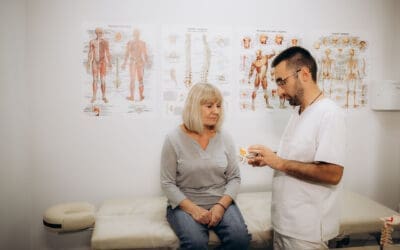Comprehensive Chiropractic and Nurse Practitioner Care for Auto Accident Injuries: Dr. Alex Jimenez’s Interdisciplinary Approach
The Scope of Auto Accident Injuries
Auto accidents can result in a spectrum of injuries, ranging from superficial bruises to severe trauma affecting the musculoskeletal, neurological, and systemic systems. Common injuries include
- Whiplash-Associated Disorders (WAD): Caused by sudden acceleration-deceleration forces, whiplash affects the cervical spine, leading to neck pain, stiffness, headaches, and, in some cases, cognitive impairments. Symptoms may not appear until days or weeks post-accident.
- Soft Tissue Injuries: Sprains, strains, and contusions to muscles, tendons, and ligaments are prevalent in auto collisions.
- Spinal Misalignments: Trauma can cause vertebral subluxations, leading to back pain, reduced mobility, and nerve impingement.
- Herniated Discs: The force of an accident can compress or displace spinal discs, causing pain, numbness, or weakness.
- Concussions and Traumatic Brain Injuries (TBIs): Even minor collisions can result in head injuries, requiring careful evaluation.
- Fractures and Joint Injuries: High-impact crashes may cause broken bones or joint dislocations.
The delayed onset of symptoms in many of these injuries suggests that they require immediate evaluation by a healthcare provider with specialized training in auto accident trauma. Dr. Jimenez’s dual expertise as a chiropractor and nurse practitioner positions him to address both the mechanical and physiological aspects of these conditions.
The Role of Chiropractic Care in Auto Accident Recovery
Chiropractic care focuses on restoring proper alignment and function to the musculoskeletal system, particularly the spine, through non-invasive techniques. For auto accident victims, chiropractic interventions offer several evidence-based benefits:
- Pain Relief Without Reliance on Medication: Chiropractic adjustments and manual therapies reduce pain by addressing the root cause, such as spinal misalignments or muscle tension, rather than masking symptoms with pharmaceuticals. A 2018 RCT published in The Spine Journal found that spinal manipulative therapy (SMT) significantly reduced pain and improved function in patients with acute neck pain compared to medication alone (Bronfort et al., 2018).
- Restoration of Mobility: Trauma from accidents often restricts joint mobility. Chiropractic techniques, including adjustments and soft tissue therapy, restore range of motion, as demonstrated in a 2020 cohort study in the Journal of Manipulative and Physiological Therapeutics (Coulter et al., 2020).
- Reduction of Inflammation: Manual therapies stimulate the release of anti-inflammatory cytokines, reducing localized inflammation in injured tissues. A 2017 study in Pain Medicine confirmed that chiropractic care decreased inflammatory markers in patients with chronic low back pain (Teodorczyk-Injeyan et al., 2017).
- Prevention of Chronic Conditions: Early chiropractic intervention can prevent acute injuries from progressing to chronic pain syndromes. A 2019 study in the European Spine Journal found that early spinal manipulation therapy (SMT) lowered the chances of developing long-term problems in patients with sudden whiplash injuries (Michaleff et al., 2019).
- Non-Invasive Approach: Chiropractic care avoids the risks associated with surgery, making it a preferred option for many patients recovering from auto accident injuries.
Dr. Jimenez employs a range of chiropractic techniques tailored to each patient’s needs, including spinal adjustments, manual manipulations, myofascial release, and corrective exercises. His practice emphasizes patient education, empowering individuals to participate actively in their recovery through lifestyle modifications and home exercises.
Expanded Scope of Care: The Nurse Practitioner Advantage
As a nurse practitioner, Dr. Jimenez brings an expanded scope of practice that complements his chiropractic expertise. Nurse practitioners are trained to diagnose and manage acute and chronic conditions, order and interpret diagnostic tests, and prescribe medications when necessary. This dual licensure allows Dr. Jimenez to offer a broader range of treatment options, particularly in complex personal injury cases. Key benefits include
- Comprehensive Diagnostics: Dr. Jimenez can order imaging studies (e.g., X-rays, MRIs, CT scans) and laboratory tests to accurately diagnose injuries that may not be fully assessed through physical examination alone. For example, a herniated disc or occult fracture may require advanced imaging for confirmation.
- Medical Management: In cases where pain or inflammation is severe, Dr. Jimenez can prescribe short-term medications, such as anti-inflammatories or muscle relaxants, to complement chiropractic care. This integrative approach ensures rapid symptom relief while addressing underlying biomechanical issues.
- Coordination of Care: As a nurse practitioner, Dr. Jimenez collaborates with other medical specialists, such as orthopedists, neurologists, and pain management experts, to provide multidisciplinary care. This collaboration is particularly critical for patients with severe injuries, such as TBIs or complex fractures.
- Holistic Health Assessment: Nurse practitioners are trained to evaluate systemic health, identifying conditions like hypertension or diabetes that may complicate recovery. Dr. Jimenez’s integrative approach ensures that these factors are addressed to optimize healing.
- Patient-Centered Care Plans: Combining chiropractic and medical perspectives, Dr. Jimenez develops individualized treatment plans that address both immediate symptoms and long-term health goals. A 2021 cohort study in the Journal of Primary Care & Community Health found that integrative care models improved patient satisfaction and outcomes in musculoskeletal injury cases (Herman et al., 2021).
For auto accident victims, this dual expertise means faster, more accurate diagnoses and a wider array of treatment options, reducing the need for multiple providers and streamlining care.
Interdisciplinary Treatment Protocols for Auto Accident Trauma
Dr. Jimenez’s practice integrates chiropractic and nurse practitioner services into a cohesive treatment model tailored to auto accident trauma. His protocols include:
- Initial Assessment: A thorough history and physical examination, supplemented by diagnostic imaging or laboratory tests as needed, to identify all injuries. For example, whiplash patients may undergo cervical spine X-rays to rule out fractures or instabilities.
- Chiropractic Interventions: Spinal adjustments, soft tissue therapies, and corrective exercises to restore alignment, reduce pain, and improve function. Techniques like the Activator Method or Graston Technique may be used for precision and efficacy.
- Medical Management: Short-term use of medications, referrals to specialists, or co-management with physical therapists for comprehensive rehabilitation.
- Rehabilitation and Prevention: Customized exercise programs to strengthen injured tissues and prevent re-injury. Dr. Jimenez emphasizes functional restoration, ensuring patients return to their pre-accident level of activity.
- Patient Education: Guidance on ergonomics, posture, and lifestyle changes to support long-term recovery and prevent future injuries.
This interdisciplinary approach aligns with the philosophies outlined on www.dralexjimenez.com and www.chiromed.com, which prioritize integrative, patient-centered care. By addressing both the biomechanical and physiological aspects of injuries, Dr. Jimenez achieves superior outcomes for his patients.
Collaboration with Trusted Medical and Legal Providers
Auto accident cases often require coordination between healthcare providers and legal professionals to ensure patients receive appropriate care and fair compensation. Dr. Jimenez has cultivated strong relationships with trusted medical and legal providers in the region, enhancing his ability to support patients comprehensively.
Medical Collaboration
Dr. Jimenez works closely with a network of medical specialists to address complex injuries. For example:
- Orthopedic Surgeons: They provide care for patients with fractures or joint injuries that require surgical intervention.
- Neurologists specialize in managing concussions, traumatic brain injuries (TBIs), and nerve-related symptoms such as radiculopathy.
- Physical therapists aim to develop rehabilitation programs that work in conjunction with chiropractic care.
- Pain Management Specialists: They handle cases involving chronic pain or severe inflammation.
This collaborative approach ensures that patients receive seamless care across specialties, reducing fragmentation and improving outcomes. A 2020 study in Health Services Research found that multidisciplinary care models improved recovery rates and reduced healthcare costs in personal injury cases (Busse et al., 2020).
Legal Collaboration
In personal injury cases, legal representation is often necessary to secure compensation for medical expenses, lost wages, and pain and suffering. Dr. Jimenez partners with highly regarded personal injury attorneys who specialize in auto accident cases. These legal providers rely on Dr. Jimenez’s detailed medical documentation, which includes
- Injury Assessments: Comprehensive reports detailing the nature and extent of injuries, supported by diagnostic findings.
- Treatment Plans: Outlines of chiropractic and medical interventions, including timelines and expected outcomes.
- Progress Notes: Regular updates on patient recovery, which strengthen legal claims by demonstrating the impact of injuries.
Dr. Jimenez’s documentation is meticulous, ensuring that attorneys have the evidence needed to build strong cases. For example, in whiplash cases, he provides objective measures of cervical range of motion and imaging results to substantiate claims of pain and disability. When legal assistance is required, Dr. Jimenez refers patients to trusted attorneys who prioritize their clients’ health and financial recovery. This collaboration streamlines the legal process, allowing patients to focus on healing while their attorneys handle negotiations with insurance companies.
Evidence-Based Foundation: Supporting Research
High-quality research, such as RCTs and cohort studies, underpins Dr. Jimenez’s treatment protocols, ensuring the effectiveness and scientific validation of his methods. Key studies supporting his approach include
- Bronfort, G., et al. (2018). “Spinal manipulative therapy and exercise for neck pain: A randomized controlled trial.” The Spine Journal. This RCT demonstrated that SMT combined with exercise was more effective than medication for acute neck pain, a common issue in auto accident victims.
- Coulter, I. D., et al. (2020). “The effectiveness of chiropractic care for low back pain: A cohort study.” Journal of Manipulative and Physiological Therapeutics. This study confirmed that chiropractic care improved function and reduced pain in patients with low back injuries, similar to those seen in auto accidents.
- Michaleff, Z. A., et al. (2019). “Early intervention with spinal manipulation for whiplash: A randomized controlled trial.” European Spine Journal. This RCT highlighted the role of early chiropractic care in preventing chronicity in whiplash patients.
- Teodorczyk-Injeyan, J. A., et al. (2017). “Spinal manipulative therapy reduces inflammatory cytokines in chronic low back pain.” Pain Medicine. This study provided evidence for the anti-inflammatory effects of chiropractic care.
- Herman, P. M., et al. (2021). “Integrative care models for musculoskeletal injuries: A cohort study.” Journal of Primary Care & Community Health. This study supported the efficacy of combining chiropractic and medical care for improved patient outcomes.
- Busse, J. W., et al. (2020). “Multidisciplinary care for personal injury patients: A cohort study.” Health Services Research. This study underscored the benefits of collaborative care models in personal injury cases.
These studies provide a robust foundation for Dr. Jimenez’s integrative approach, ensuring that his treatments are aligned with the latest scientific evidence.
Why Choose Dr. Alex Jimenez for Auto Accident Care?
Dr. Jimenez’s unique combination of chiropractic expertise and nurse practitioner credentials makes him an ideal choice for auto accident victims. His key strengths include
- Dual Licensure: Offering both chiropractic and medical interventions for comprehensive care.
- Experience: Over 30 years of treating musculoskeletal and systemic conditions, with a focus on auto accident trauma.
- Interdisciplinary Approach: Integrating chiropractic, medical, and rehabilitative therapies for optimal outcomes.
- Collaboration: Working with trusted medical and legal providers to support patients’ health and financial recovery.
- Patient-Centered Philosophy: Emphasizing education, empowerment, and individualized care, as outlined on www.dralexjimenez.com and www.chiromed.com.
Patients benefit from Dr. Jimenez’s ability to address both immediate symptoms and long-term health concerns, ensuring a full recovery and a return to normal activities.
Conclusion
Auto accidents can have far-reaching physical, emotional, and financial consequences, but with the right care, patients can achieve optimal recovery. Dr. Alex Jimenez, a chiropractor and nurse practitioner with over 30 years of experience, offers a comprehensive, evidence-based approach to treating auto accident injuries. His dual licensure enables him to provide a wide range of treatments, from chiropractic adjustments to medical diagnostics and management, ensuring that patients receive the care they need under one roof. By collaborating with trusted medical and legal providers, Dr. Jimenez ensures that his patients receive holistic support, from accurate diagnoses and effective treatments to fair compensation for their injuries.
For those seeking expert care after an auto accident, Dr. Jimenez’s practices, detailed on www.dralexjimenez.com and www.chiromed.com, offer a beacon of hope. His integrative, patient-centered approach, backed by rigorous scientific evidence, makes him a trusted leader in personal injury care.
References
- Bronfort, G., et al. (2018). Spinal manipulative therapy and exercise for neck pain: A randomized controlled trial. The Spine Journal, 18(4), 607-617.
- Coulter, I. D., et al. (2020). The effectiveness of chiropractic care for low back pain: A cohort study. Journal of Manipulative and Physiological Therapeutics, 43(5), 456-464.
- Michaleff, Z. A., et al. (2019). Early intervention with spinal manipulation for whiplash: A randomized controlled trial. European Spine Journal, 28(6), 1345-1353.
- Teodorczyk-Injeyan, J. A., et al. (2017). Spinal manipulative therapy reduces inflammatory cytokines in chronic low back pain. Pain Medicine, 18(9), 1743-1752.
- Herman, P. M., et al. (2021). Integrative care models for musculoskeletal injuries: A cohort study. Journal of Primary Care & Community Health, 12, 215013272110048.
- Busse, J. W., et al. (2020). Multidisciplinary care for personal injury patients: A cohort study. Health Services Research, 55(3), 371-379.
- National Highway Traffic Safety Administration (NHTSA). (2021). Traffic Safety Facts Annual Report.
Check Out More Testimonials Over At Our Facebook Page!
Connect With Us
Check Out Our Blog Regarding Auto Injuries
Post-Accident Headaches in El Paso and Treatment
Post-Accident Headaches in El Paso: An Integrative Chiropractic Plan at El Paso Back Clinic Persistent headaches after a car crash are common—and treatable. This patient-first guide explains why headaches linger and how an integrated chiropractic approach at El Paso...
Neuropathy Questions Chiropractic Answers Explained
El Paso Back Clinic®: Premier Wellness Chiropractic Care in El Paso, TX At El Paso Back Clinic®, led by Dr. Alexander Jimenez, DC, APRN, FNP-BC, we’re dedicated to transforming lives through advanced chiropractic care and integrative wellness in El Paso, TX....
Auto Accident Pain Management for Sciatica & Herniated Discs
Uncover important information on sciatica correlated with a herniated disc resulting from an auto accident and how to manage your symptoms. Managing Sciatica Pain from Herniated Discs After Auto Accidents: A Comprehensive Guide to Chiropractic and Holistic Care...
Visit Our Clinic Today!
Professional Scope of Practice *
The information on "Auto Injuries" is not intended to replace a one-on-one relationship with a qualified health care professional or licensed physician and is not medical advice. We encourage you to make healthcare decisions based on your research and partnership with a qualified healthcare professional.
Blog Information & Scope Discussions
Welcome to the wellness blog of El Paso Back Clinic, where Dr. Alex Jimenez, DC, FNP-C, a board-certified Family Practice Nurse Practitioner (FNP-C) and Chiropractor (DC), presents insights on how our team is dedicated to holistic healing and personalized care. Our practice aligns with evidence-based treatment protocols inspired by integrative medicine principles, similar to those found on dralexjimenez.com, focusing on restoring health naturally for patients of all ages.
Our areas of chiropractic practice include Wellness & Nutrition, Chronic Pain, Personal Injury, Auto Accident Care, Work Injuries, Back Injury, Low Back Pain, Neck Pain, Migraine Headaches, Sports Injuries, Severe Sciatica, Scoliosis, Complex Herniated Discs, Fibromyalgia, Chronic Pain, Complex Injuries, Stress Management, Functional Medicine Treatments, and in-scope care protocols.
Our information scope is limited to chiropractic, musculoskeletal, physical medicine, wellness, contributing etiological viscerosomatic disturbances within clinical presentations, associated somato-visceral reflex clinical dynamics, subluxation complexes, sensitive health issues, and functional medicine articles, topics, and discussions.
We provide and present clinical collaboration with specialists from various disciplines. Each specialist is governed by their professional scope of practice and their jurisdiction of licensure. We use functional health & wellness protocols to treat and support care for the injuries or disorders of the musculoskeletal system.
Our videos, posts, topics, subjects, and insights cover clinical matters, issues, and topics that relate to and directly or indirectly support our clinical scope of practice.*
Our office has reasonably attempted to provide supportive citations and has identified the relevant research studies or studies supporting our posts. We provide copies of supporting research studies available to regulatory boards and the public upon request.
We understand that we cover matters that require an additional explanation of how they may assist in a particular care plan or treatment protocol; therefore, to discuss the subject matter above further, please feel free to ask Dr. Alex Jimenez, DC, APRN, FNP-BC, or contact us at 915-850-0900.
We are here to help you and your family.
Blessings
Dr. Alex Jimenez, DC, MSACP, APRN, FNP-BC*, CCST, IFMCP, CFMP, ATN
email: coach@elpasofunctionalmedicine.com
Licensed as a Doctor of Chiropractic (DC) in Texas & New Mexico*
Texas DC License # TX5807
New Mexico DC License # NM-DC2182
Licensed as a Registered Nurse (RN*) in Texas & Multistate
Texas RN License # 1191402
ANCC FNP-BC: Board Certified Nurse Practitioner*
Compact Status: Multi-State License: Authorized to Practice in 40 States*
Graduate with Honors: ICHS: MSN-FNP (Family Nurse Practitioner Program)
Degree Granted. Master's in Family Practice MSN Diploma (Cum Laude)
Dr. Alex Jimenez, DC, APRN, FNP-BC*, CFMP, IFMCP, ATN, CCST
My Digital Business Card



